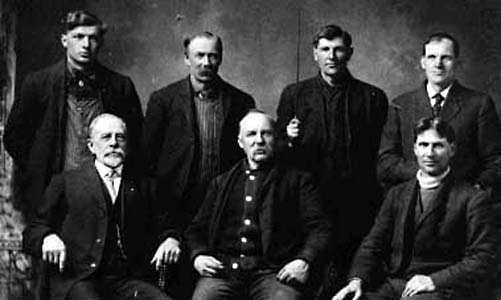Search | Image Archive | Reference | Communities | POV | Lesson Plans | Credits
 One of the key problems which faced new immigrants to Manitoba was learning how to farm the prairie. Techniques which had been successful in Europe and Ontario were not well suited to Manitoba, particularly the semi-arid regions in the south-west. Manitobans and their government therefore recognized early the value of agricultural education.
One of the key problems which faced new immigrants to Manitoba was learning how to farm the prairie. Techniques which had been successful in Europe and Ontario were not well suited to Manitoba, particularly the semi-arid regions in the south-west. Manitobans and their government therefore recognized early the value of agricultural education.
The task of agricultural education was first taken up by local agricultural societies which began to appear in the 1870s. These were independent, voluntary organizations which were committed to the sharing and spread of knowledge about farming. They attracted primarily established farmers, and they became an important part of the social and political life of Manitoba's early farming élite.
By the 1890s these societies were largely displaced by the farmers institutes, local bodies affiliated with a central co-ordinating body called the Manitoba Central Farmers' Institute (MCFI). The institutes co-ordinated lectures, demonstrations and seminars, generally in the winter months and were attended mostly by affluent male farmers who wanted to discuss public policy and farming technique.
In the end, these agricultural institutes failed to meet the needs of a large part of the farm population. Those attending seminars and presenting papers tended to represent a narrow segment of the overall rural population. They were overwhelmingly older and male and prosperous. They did not provide agricultural education to new immigrants, to young farmers or to women. By the turn of the century, pressure was building on the provincial government, largely from farm women and the agricultural press, to take a broader role in agricultural education, and in 1905, a Deputy Minister of Agriculture was appointed to oversee agricultural education.
Under W. J. Black, the first such deputy minister, the province assumed a much more active role. Agricultural societies and institutes were brought under more central control and associated with the Manitoba Agricultural College, established in 1905 with Black as president. In 1907, the arrangement was formalized with the passage of the Agricultural Instruction Act, which facilitated the creation of the Agricultural Extension Services, a central body which oversaw the broadening of agricultural education in the province.
Page revised: 28 August 2009